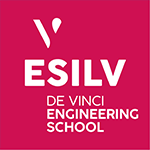
Zhiqiang WANG received his PhD in 2021 from Ecole Centrale Nantes, France, in the field of data mining and machine learning in the machining industry. He developed an AI-based decision support system for Airbus, which was funded by the French ANR project SmartEmma. As a postdoctoral research fellow in 2022, he developed an intelligent natural language processing (NLP) based failure analysis system for the semiconductor industry funded by the European project FA 4.0. Since 2022, he has been an assistant professor at the Leonard de Vinci Graduate School of Engineering. His research interests include AI-based failure analysis, intelligent decision support system based on multimodal data (numericcal, textual and image) in the framework of smart manufacturing, Machine learning, Deep learning, Natural Language Processing (NLP) and Computer Vision (CV) applied in aeronautic machining, Addictive manufacturing and Hybrid manufacturing. He is the coordinator of the PULSAR project for young researchers in Pays de la Loire in France - Artificial Intelligence for Failure Analysis. He is also the coordinator of the Central Groupes with CSC programme - AI-based Failure Analysis Using Multimodal Data in the Framework of Smart manufacturing. He is also an invited expert in the French ANR project ReSilientGAIA.
Ni ZHU; Ruiwen He; Zhiqiang Wang
Dans: Engineering Applications Of Artificial Intelligence, vol. 145, p. 110160, 2025.
@article{zhu_3394,
title = {CarNet: A generative convolutional neural network-based line-of-sight/non-line-of-sight classifier for global navigation satellite systems by transforming multivariate time-series data into images},
author = {Ni ZHU and Ruiwen He and Zhiqiang Wang},
url = {https://www.sciencedirect.com/science/article/pii/S0952197625001605?via%3Dihub},
year = {2025},
date = {2025-04-01},
journal = {Engineering Applications Of Artificial Intelligence},
volume = {145},
pages = {110160},
abstract = {Urban environments present significant challenges to commercial Global Navigation Satellite Systems (GNSS) receivers due to degraded satellite visibility and Non-line-of-sight (NLOS) receptions. Mitigating NLOS receptions for GNSS is essential, especially for safety-critical and reliability-critical location-based applications. Traditional physical error channel propagation modeling encountered bottlenecks since the NLOS and multipath errors cannot be modeled accurately in complex urban environments. Data-driven methods show significant potential for effectively classifying GNSS Line-of-sight (LOS) and NLOS. This paper proposes the CarNet - a generative Convolutional Neural Network (CNN)-based GNSS LOS/NLOS classifier by transforming multivariate time-series data into images. CarNet comprises two modules: an image generator and an image classifier. The image generator enriches and augments the original 1-dimension feature vector into 2-dimension feature maps and the image classifier uses an inception-based CNN to realize multi-scale feature extraction and classification. The proposed architecture is trained and tested on more than 6 h of real vehicle data collected in different challenging environments (about 1.6 million samples). A thorough benchmark is conducted, comparing CarNet against the existing mainstream Artificial Intelligence (AI) methods. The results with cross-validation on unseen data indicate that CarNet achieves the highest accuracy, i.e., 81.47% while maintaining the optimal balance between precision for both classes: 83.3% for LOS and 70.99% for NLOS. Finally, positioning accuracy is assessed using a reweighting strategy based on the LOS/NLOS information predicted by CarNet. The assessment of total datasets shows that CarNet weighting can achieve the best accuracy compared to the traditional weighting schemes based on signal-to-noise ratio or satellite elevation. CarNet shows strong potential for embedding into GNSS receivers to enhance positioning accuracy in complex urban environments, benefiting a wide range of location-based applications such as autonomous driving, emergency response, and urban logistics.},
keywords = {},
pubstate = {published},
tppubtype = {article}
}
Zhiqiang Wang; Kenneth Ezukwoke; Anis Hoayek; Mireille Batton-Hubert; Xavier Boucher
Nature language processing (NLP) and association rules (AR)-based knowledge extraction for intelligent fault analysis: a case study in semiconductor industry Article de journal
Dans: Journal Of Intelligent Manufacturing, vol. 35, no. 9, p. 1-16, 2023.
@article{wang_2482,
title = {Nature language processing (NLP) and association rules (AR)-based knowledge extraction for intelligent fault analysis: a case study in semiconductor industry},
author = {Zhiqiang Wang and Kenneth Ezukwoke and Anis Hoayek and Mireille Batton-Hubert and Xavier Boucher},
url = {https://link.springer.com/article/10.1007/s10845-023-02245-7},
year = {2023},
date = {2023-11-01},
journal = {Journal Of Intelligent Manufacturing},
volume = {35},
number = {9},
pages = {1-16},
abstract = {Fault analysis (FA) is the process of collecting and analyzing data to determine the cause of a failure. It plays an important role in ensuring the quality in manufacturing process. Traditional FA techniques are time-consuming and labor-intensive, relying
heavily on human expertise and the availability of failure inspection equipment. In semiconductor industry, a large amount of FA reports are generated by experts to record the fault descriptions, fault analysis path and fault root causes. With the development of Artificial Intelligence, it is possible to automate the industrial FA process while extracting expert knowledge from the vast FA report data. The goal of this research is to develop a complete expert knowledge extraction pipeline for FA in semiconductor industry based on advanced Natural Language Processing and Machine Learning. Our research aims at automatically predicting the fault root cause based on the fault descriptions. First, the text data from the FA reports are transformed into numerical data using Sentence Transformer embedding. The numerical data are converted into latent spaces using Generalized-Controllable Variational AutoEncoder. Then, the latent spaces are classified by Gaussian Mixture Model. Finally, Association Rules are applied to establish the relationship between the labels in the latent space of the fault descriptions and that of the fault root cause. The proposed algorithm has been evaluated with real data of semiconductor industry collected
over three years. The average correctness of the predicted label achieves 97.8%. The method can effectively reduce the time of failure identification and the cost during the inspection stage.},
keywords = {},
pubstate = {published},
tppubtype = {article}
}
Asma Ladj; Zhiqiang Wang; Oussama Meski; Farouk Belkadi; Mathieu Ritou; Catherine DA CUNHA
A knowledge-based Digital Shadow for machining industry in a Digital Twin perspective Article de journal
Dans: Journal Of Manufacturing Systems, vol. 58, no. Part B, p. 168-179, 2020.
@article{ladj_1967,
title = {A knowledge-based Digital Shadow for machining industry in a Digital Twin perspective},
author = {Asma Ladj and Zhiqiang Wang and Oussama Meski and Farouk Belkadi and Mathieu Ritou and Catherine DA CUNHA},
url = {https://doi.org/10.1016/j.jmsy.2020.07.018},
year = {2020},
date = {2020-06-01},
journal = {Journal Of Manufacturing Systems},
volume = {58},
number = {Part B},
pages = {168-179},
abstract = {This paper addresses the problems of data management and analytics for decision-aid by proposing a new vision of Digital Shadow (DS) which would be considered as the core component of a future Digital Twin. Knowledge generated by experts and artificial intelligence, is transformed into formal business rules and integrated into the DS to enable the characterization of the real behavior of the physical system throughout its operation stage. This behavior model is continuously enriched by direct or derived learning, in order to improve the digital twin. The proposed DS relies on data analytics (based on unsupervised learning) and on a knowledge inference engine. It enables the incidents to be detected and it is also able to decipher its operational context. An example of this application in the aeronautic machining industry is provided to stress both the feasibility of the proposition and its potential impact on shop floor performance.},
keywords = {},
pubstate = {published},
tppubtype = {article}
}
Zhiqiang Wang; Mathieu Ritou; Catherine Da Cugna; Benoît Furet
Contextual classification for smart machining based on unsupervised machine learning by Gaussian mixture model Article de journal
Dans: International Journal Of Computer Integrated Manufacturing, vol. 33, no. 10-11, p. 1042-1054, 2020.
@article{wang_1966,
title = {Contextual classification for smart machining based on unsupervised machine learning by Gaussian mixture model},
author = {Zhiqiang Wang and Mathieu Ritou and Catherine Da Cugna and Benoît Furet},
url = {https://doi.org/10.1080/0951192X.2020.1775302},
year = {2020},
date = {2020-05-01},
journal = {International Journal Of Computer Integrated Manufacturing},
volume = {33},
number = {10-11},
pages = {1042-1054},
abstract = {Intelligent machine-tools generate a large amount of digital data. Data mining can support decision-making for operational management. The first step in a data mining approach is the selection of relevant data. Raw data must, therefore, be classified into different groups of contexts. This paper proposes an original contextual classification of data for smart machining based on unsupervised machine learning by Gaussian mixture model. The optimal number of classes is determined by the silhouette method based on the Bayesian information criterion. This method is validated on real data from four different machine-tools in the aerospace industry. Manual data mining and k-fold cross-validation confirm that the proposed method provides good contextual classification results. Then, several key performance indicators are calculated using this contextual classification. They show the relevancy of the approach.},
keywords = {},
pubstate = {published},
tppubtype = {article}
}
EOZENOU Fabien; Chel Stéphane; Gasser Yves; Servouin Christophe; Visentin Bernard; Charrier Jean-Pierre; Zhiqiang Wang
Development of an advanced electropolishing setup for multicell high gradient niobium cavities Article de journal
Dans: Physical Review Accelerators And Beams, vol. 15, no. 8, p. 083501, 2012.
@article{fabien_2610,
title = {Development of an advanced electropolishing setup for multicell high gradient niobium cavities},
author = {EOZENOU Fabien and Chel Stéphane and Gasser Yves and Servouin Christophe and Visentin Bernard and Charrier Jean-Pierre and Zhiqiang Wang},
url = {https://journals.aps.org/prab/abstract/10.1103/PhysRevSTAB.15.083501},
year = {2012},
date = {2012-08-01},
journal = {Physical Review Accelerators And Beams},
volume = {15},
number = {8},
pages = {083501},
abstract = {Reproducible operation at high performances of superconducting cavities is required for linear accelerators. High beta elliptical cavities are thus of concern and, to achieve required performances for such resonators, surface preparation including electropolishing is recommended. We have designed and operate a setup for electropolishing in the vertical position of multicell cavities in order to: (i) obtain high yield with large elliptical cavities for Superconducting Linac (SPL) or European Spallation Source
projects; (ii) develop a reference installation demonstrating that this process is appropriate for the large scale treatment of cavities in industry. The setup described here is the first one able to electropolish vertically multicell cavities with circulating acid and high safety standards. This equipment makes it possible to use a wide range of parameters such as voltage, acid flow rate, temperature, and nitrogen injection with an R&D purpose in mind. Optimization is studied using modeling with COMSOL software for different cavities. As examples, we present some results for the 704 MHz high-beta SPL cavity and the 1300 MHz International Linear Collider cavity and show the influence of cathode shape on both acid flow and electric field distribution during the process. Importance of the size of the cavity and first results achieved on single-cell and nine-cell cavities will be discussed.},
keywords = {},
pubstate = {published},
tppubtype = {article}
}
Zhiqiang Wang
Intelligent failure analysis for industry 4.0 based on multimodal data: Progress and challenges Conférence
The 4th Digital Twin International Conference, Taylor & Francis Group, Milan, Italie, 2024.
@conference{wang_3195,
title = {Intelligent failure analysis for industry 4.0 based on multimodal data: Progress and challenges},
author = {Zhiqiang Wang},
url = {http://www.dtiac.com/},
year = {2024},
date = {2024-10-01},
booktitle = {The 4th Digital Twin International Conference},
publisher = {Taylor & Francis Group},
address = {Milan, Italie},
abstract = {Failure Analysis (FA) involves analyzing production data to identify root causes of failures and develop strategies to eliminate Failure Mechanisms (FM), crucial in industries like automotive, aerospace, marine, and semiconductors. In these sectors, failures may arise from manufacturing, design, environmental factors, or maintenance issues. With advances in AI, automating FA using multimodal data (numerical, textual, image) is increasingly feasible. AI techniques such as Natural Language Processing (NLP) and computer vision convert this data into numerical formats for modeling with machine learning. This study predicts failure causes using AI on multimodal data from industry settings. A classification method applied to aeronautical machining data achieves 98.9% accuracy, and an NLP approach evaluated on semiconductor data reaches 97.8% accuracy. These methods help experts identify failure causes more accurately and efficiently. Future work will focus on developing a decision-aid system using multimodal data within a digital twin framework.},
keywords = {},
pubstate = {published},
tppubtype = {conference}
}
Zhiqiang Wang
Digital Twin driven smart manufacturing based on multimodal data Conférence
The 3rd Digital Twin International Conference, online, France, 2023.
@conference{wang_2460,
title = {Digital Twin driven smart manufacturing based on multimodal data},
author = {Zhiqiang Wang},
url = {https://digitwin2023.sciencesconf.org/},
year = {2023},
date = {2023-10-01},
booktitle = {The 3rd Digital Twin International Conference},
address = {online, France},
abstract = {In the context of Industry 4.0, large volumes of manufacturing data are available on industry. This paper aims to develop a digital twin system as a decision support tool for smart manufacturing based on multimodal data. The proposed system relies on artificial intelligence (AI) and knowledge integration. This system, controlled by the digital twin, can be used for intelligent monitoring, failure analysis, control, manufacturing processes. In the end, it learns all
sources of information (customer demand, supply chain, financial status, maintenance, planning, production line, quality, etc.) that should be in multimodal data (numeric, text, and image) and provides managers with the
most reasonable decisions based on AI and knowledge inference.},
keywords = {},
pubstate = {online},
tppubtype = {conference}
}
Zhiqiang Wang; Mathieu Ritou; Benoît Furet
Contextual classification of chatter based on unsupervised machine learning Proceedings Article
Dans: Procedia CIRP 19th CIRP Conference on Modeling of Machining Operations, p. 390-395, Karlsruhe, Germany, 2023, ISBN: 2212-8271.
@inproceedings{wang_2364,
title = {Contextual classification of chatter based on unsupervised machine learning},
author = {Zhiqiang Wang and Mathieu Ritou and Benoît Furet},
url = {https://www.sciencedirect.com/science/article/pii/S2212827123001981},
issn = {2212-8271},
year = {2023},
date = {2023-06-01},
booktitle = {Procedia CIRP 19th CIRP Conference on Modeling of Machining Operations},
volume = {117},
pages = {390-395},
address = {Karlsruhe, Germany},
abstract = {In the context of Industry 4.0, large volumes of manufacturing data are available on instrumented machine-tool. The critical point is the
exploitation of this digital content. Data contextualization is important for efficient and robust data mining, particularly for industrial production. For this purpose, a classification method of the operational manufacturing context is proposed. It relies on knowledge integration (by business rules) and unsupervised machine learning, with a Gaussian Mixture Model, applied to in-process monitoring signals. The method was evaluated on real industrial machining databases collected during one year. Manual data mining shows that this method is accurate on industrial production (98.9%). Moreover, the application of contextual classifications for the chatter detection on the same production data shows the relevancy of the proposed data mining approach.},
keywords = {},
pubstate = {published},
tppubtype = {inproceedings}
}
Zhiqiang Wang; Kenneth Ezukwoke; Anis Hoayek; Mireille Batton-Hubert; Xavier Boucher
NLP based on GCVAE for intelligent Fault Analysis in Semiconductor industry Proceedings Article
Dans: 2022 IEEE 27th International Conference on Emerging Technologies and Factory Automation (ETFA), Stuttgart, Germany, 2022, ISBN: 9781665499972.
@inproceedings{wang_2365,
title = {NLP based on GCVAE for intelligent Fault Analysis in Semiconductor industry},
author = {Zhiqiang Wang and Kenneth Ezukwoke and Anis Hoayek and Mireille Batton-Hubert and Xavier Boucher},
url = {https://ieeexplore.ieee.org/document/9921524},
issn = {9781665499972},
year = {2022},
date = {2022-10-01},
booktitle = {2022 IEEE 27th International Conference on Emerging Technologies and Factory Automation (ETFA)},
address = {Stuttgart, Germany},
abstract = {In the semiconductor industry, Failure Analysis (FA) is an investigation to determine the root causes of a failure. It also involves an intermediate analysis to build the steps of the failure analysis in order to mitigate future failures and to facilitate the future FA. In the framework of the FA 4.0 project, the reporting system records three items of information using natural language: the failure analysis request description (input space) and analysis steps (paths), as well as generic categories of root cause conclusion (output space). The main objective of this article is to develop a system which is able to automatically help industries carry out fault analysis diagnoses with Artificial intelligence (AI). This article extends and validates the adapted methodology proposed by [1] to transform text data into numeric data based on Natural Language Processing (NLP). It transforms the text data from the input space and output space. Different deep learning algorithms based on a Variational AutoEncoder (VAE) are applied to the output space to reduce the dimension of the numeric data, and the performance of each VAE is evaluated with different metrics. The Generalized-Controllable VAE (GCVAE) is the one best suited to our case. A Gaussian Mixture Model (GMM) is then used to perform clustering in the latent space generated by the GCVAE. A centroid analysis is also conducted to verify the similarity of each cluster.},
keywords = {},
pubstate = {published},
tppubtype = {inproceedings}
}
Zhiqiang Wang; Mathieu Ritou; Catherine DA CUNHA; Benoît Furet
Identification du contexte d'usinage basée sur le modèle de mélange gaussien : application au broutement. Proceedings Article
Dans: Conférence Manufacturing'21 2021, Angers, France, 2021.
@inproceedings{wang_2623,
title = {Identification du contexte d'usinage basée sur le modèle de mélange gaussien : application au broutement.},
author = {Zhiqiang Wang and Mathieu Ritou and Catherine DA CUNHA and Benoît Furet},
url = {https://hal.science/hal-03436801/},
year = {2021},
date = {2021-07-01},
booktitle = {Conférence Manufacturing'21 2021},
address = {Angers, France},
abstract = {Les machines-outils intelligentes gérèrent de nombreuses données et l'exploration de ces données peut faciliter la prise de décision en matière de gestion opérationnelle. Une sélection fine des données pertinentes, basée sur le contexte d'usinage, est nécessaire pour un calcul précis des indicateurs clés de performance (KPIs). Il s'agit d'une étape importante pour une exploration efficace des données. Cet article propose ainsi des règles métiers pour la classification contextuelle, basée sur un apprentissage automatique non-supervisé par le Modèle de Mélange Gaussien (GMM). Les fouilles des données manuelles montrent que la précision de la méthode est très bonne. Dés lors, différents types d'usinage et différent états de l'engagement de l'outil peuvent être identifiées automatiquement à chaque instant, par cette classification contextuelle. Ainsi, des KPIs, tel que la distribution des cas de broutement par type d'usinage ou d'engagement de l'outil, peuvent être évalués sur la base de cette classification contextuelle.},
keywords = {},
pubstate = {published},
tppubtype = {inproceedings}
}
Zhiqiang Wang; Catherine DA CUNHA; Mathieu Ritou; Benoît Furet
Comparison of K-means and GMM methods for contextual clustering in HSM Proceedings Article
Dans: Procedia Manufacturing, p. 154-159, Elsevier, Nantes, France, 2019, ISBN: 2351-9789.
@inproceedings{wang_1968,
title = {Comparison of K-means and GMM methods for contextual clustering in HSM},
author = {Zhiqiang Wang and Catherine DA CUNHA and Mathieu Ritou and Benoît Furet},
url = {https://doi.org/10.1016/j.promfg.2018.12.025},
issn = {2351-9789},
year = {2019},
date = {2019-08-01},
booktitle = {Procedia Manufacturing},
volume = {28},
pages = {154-159},
publisher = {Elsevier},
address = {Nantes, France},
abstract = {High speed machining (HSM) is widely used for the manufacturing of aircraft structures, turbine blades, etc. It greatly increases the efficiency and automation for the machining. However, in HSM, operators cannot detect incidents when they manage several machines of a production cell. Robust monitoring systems are required to protect the machine tool and the high value added parts. In the global context of the Industry 4.0, abundant digital data is available in a modern manufacturing company and could be used to turn the machines-tools smarter and to support the decision making of the operational management.
One of the first step of data mining approach is the accurate selection of relevant. To do so, the raw data need to be classified into different contextual clusters. This paper compares two different methods of the unsupervised classification of machining context: K-means and GMM (Gaussian Mixture Model). It was found that GMM method can classify correctly the machining context, whereas K-means is not suitable.},
keywords = {},
pubstate = {published},
tppubtype = {inproceedings}
}
Zhiqiang Wang; Mathieu Ritou; Catherine DA CUNHA; Benoît Furet
Classification contextuelle pour les fouilles de données issues de machines-outils. Proceedings Article
Dans: 24ème Congrès Français de Mécanique, Brest, France, 2019.
@inproceedings{wang_2621,
title = {Classification contextuelle pour les fouilles de données issues de machines-outils.},
author = {Zhiqiang Wang and Mathieu Ritou and Catherine DA CUNHA and Benoît Furet},
url = {https://hal.science/hal-02279417/document},
year = {2019},
date = {2019-08-01},
booktitle = {24ème Congrès Français de Mécanique},
address = {Brest, France},
abstract = {Dans le contexte général de l'Industrie 4.0, une entreprise de fabrication moderne dispose de nombreuses données numériques qui pourraient être utilisées pour rendre les machines-outils plus
intelligentes et faciliter la prise de décision en matière de gestion opérationnelle. L'une des premières étapes de l'approche d'exploration de données est la sélection précise de données pertinentes. Pour ce faire, les données brutes doivent être classées dans différents groupes de contexte. Cet article présente un algorithme d'apprentissage automatique non-supervisé, par mélanges gaussiens (GMM), pour la classification contextuelle. Le nombre de clusters optimal est déterminé par le critère BIC (Bayesian Information Criterion), à partir de données venant de l'industrie aéronautique. Les vérifications par fouilles manuelles et la validation par k-fold montrent ensuite que la méthode GMM permet d'obtenir de bons résultats de classification contextuelle.},
keywords = {},
pubstate = {published},
tppubtype = {inproceedings}
}
Zhiqiang Wang; Mathieu Ritou; Catherine DA CUNHA; Benoît Furet
Classification contextuelle pour système d'aide à la décision pour machines-outils. Proceedings Article
Dans: 16ème colloque national S-mart AIP-PRIMECA, Les Karellis, France, 2019.
@inproceedings{wang_2618,
title = {Classification contextuelle pour système d'aide à la décision pour machines-outils.},
author = {Zhiqiang Wang and Mathieu Ritou and Catherine DA CUNHA and Benoît Furet},
url = {https://hal.science/hal-02100713/document},
year = {2019},
date = {2019-04-01},
booktitle = {16ème colloque national S-mart AIP-PRIMECA},
address = {Les Karellis, France},
abstract = {Dans le contexte général de l'Industrie 4.0, une entreprise de fabrication moderne dispose de nombreuses données numériques qui pourraient être utilisées pour rendre les machines-outils plus intelligentes et faciliter la prise de décision en matière de gestion opérationnelle. L'une des premières étapes de l'approche d'exploration de données est la sélection précise de données
pertinentes. Pour ce faire, les données brutes doivent être classées
dans différents groupes de contextes. Cet article présente une étude comparative d'algorithmes d'apprentissage automatique non-
supervisé pour la classification contextuelle ; qui est utile pour un
système d'aide à la décision pour machines-outils. Les vérifications
par fouilles manuelles montrent que la méthode GMM permet d'obtenir de bons résultats de classification contextuelle, contrairement à celle des K-means.},
keywords = {},
pubstate = {published},
tppubtype = {inproceedings}
}
EOZENOU Fabien; Chel Stéphane; Zhiqiang Wang; Gasser Yves; Jean Pierre Poupeau; Servouin Christophe
Vertical electro-polishing at CEA saclay: commissioning of a new set-up and modeling of the process applied to different cavities. Proceedings Article
Dans: Proc. 15th International Conference on RF Superconductivity, p. 549-554, Chicago, ILLonois, USA, 2011.
@inproceedings{fabien_2614,
title = {Vertical electro-polishing at CEA saclay: commissioning of a new set-up and modeling of the process applied to different cavities.},
author = {EOZENOU Fabien and Chel Stéphane and Zhiqiang Wang and Gasser Yves and Jean Pierre Poupeau and Servouin Christophe},
url = {https://epaper.kek.jp/SRF2011/papers/tupo062.pdf},
year = {2011},
date = {2011-08-01},
booktitle = {Proc. 15th International Conference on RF Superconductivity},
pages = {549-554},
address = {Chicago, ILLonois, USA},
abstract = {Reproducible operation at high performances of sc cavities is required for superconducting linacs, at least in their high energy section in the case of accelerators for proton beams. High beta elliptical cavities are thus of concern, and, to achieve required performances for such cavities, surface preparation including electro-polishing (EP) is recommended. Moreover, for large dimension cavities we consider the EP treatment in vertical configuration (abbreviated as VEP) to be more appropriate. For this reasons, a VEP set-up has been designed at Saclay for the electro-polishing of muticells elliptical cavities. Chosen equipment will make it possible to use a wide range of parameters (voltage, flowrate, temperature, nitrogen inerting) with R&D purpose in mind.
Optimization will be done using modeling with COMSOL software for different cavities. As examples, we present some results for the 704 MHz high-beta SPL cavity and the 1300 MHz ILC cavity and show the influence of cathode shape on both acid flow and electric field
distribution during the process. At last, importance of the size of the cavity will be commented.},
keywords = {},
pubstate = {published},
tppubtype = {inproceedings}
}
Zhiqiang Wang
Decision-aid in machining based on business rules and unsupervised machine learning Thèse
Nantes University, 2020.
@phdthesis{wang_2626,
title = {Decision-aid in machining based on business rules and unsupervised machine learning},
author = {Zhiqiang Wang},
url = {https://hal.science/tel-03900893/},
year = {2020},
date = {2020-12-01},
address = {IUT de Nantes-Campus de Carquefou},
school = {Nantes University},
keywords = {},
pubstate = {published},
tppubtype = {phdthesis}
}
No posts by this author.
N'hésitez pas à contacter le service des admissions pour tout renseignement complémentaire :










